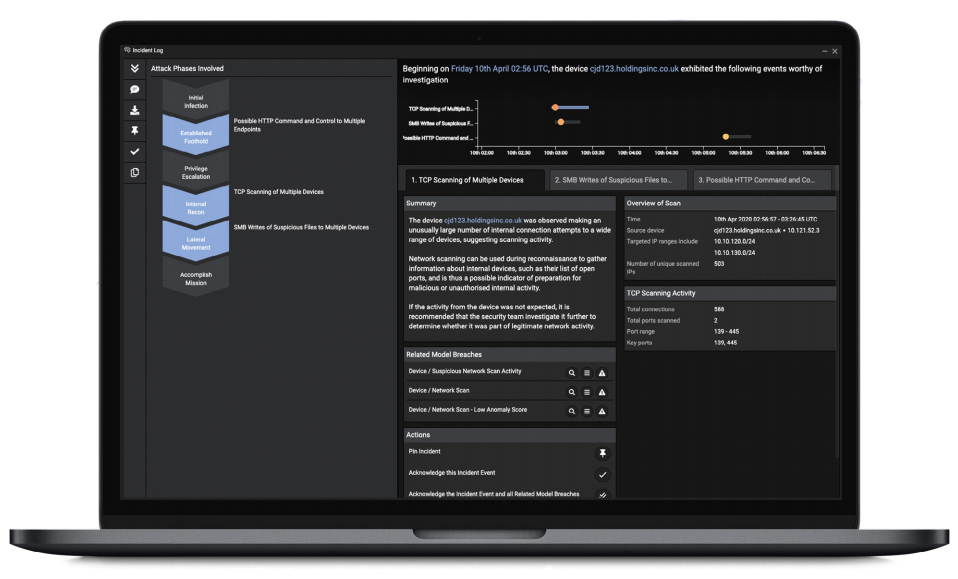Overview
Cyber AI Analyst is Darktrace’s AI investigation technology, which automatically triages, interprets, and reports on the full scope of security incidents.
Automates investigations at speed and scale
Mimics analyst intuition and continually investigates 100% of threats detected
Prioritizes the most relevant incidents
Surfaces and summarizes every urgent incident as it emerges
Writes reports in the form of a digestible narrative
Generates Incident Reports that immediately put teams in a position to take action
The myriad of security tools used by businesses today creates massive quantities of data and surfaces too many alerts for analysts to effectively manage. As threats become increasingly sophisticated and the cyber security industry continues to face a skills shortage, over-worked and under-resourced teams urgently need augmentation.
Cyber AI Analyst, the product of a research initiative from Darktrace’s R&D Center in Cambridge, was built to augment security teams and optimize threat investigation. It continuously examines every event that arises in Darktrace’s Enterprise Immune System, emulating expert human thought processes for autonomous triaging and reporting.
The technology combines expert analyst intuition with the consistency, speed, and scalability of AI. It illuminates the highest priority threats at any one time and rapidly synthesizes all of the context around an attack into a human-readable report.
By applying a combination of supervised and unsupervised machine learning, as well as deep learning methods and advanced mathematics, Cyber AI Analyst can do much of the heavy lifting a human would otherwise have to do. It leverages insights collected from Darktrace’s world-class experts over years of threat investigation to make highly accurate decisions and offers this wealth of knowledge to the public for the first time.
With Cyber AI Analyst, time-to-meaning and time-to-response are dramatically reduced – allowing your team the time to use their expertise where it really matters.
A key feature of the immune system approach and enabled by artificial intelligence, Cyber AI Analyst can sift through large volumes of data at a speed and scale, augmenting human teams and buying back time to focus on strategic work.
Its investigations are enterprise-wide, allowing the technology to piece together disparate anomalies before settling on a high-level conclusion about the nature, root cause, and extent of the wider security incident. This powerful analytical capability has been found to reduce triage time by up to 92%.
Cyber AI Analyst applies various forms of artificial intelligence, including deep learning, as well as supervised machine learning on the ever-growing data set that captures how Darktrace’s human analysts investigate threats.
With this knowledge, Cyber AI Analyst is able to understand which threats are most crucial for investigation, which events constitute a connected incident, and how an attack should be managed.
This is a powerful capability considering that the Enterprise Immune System often surfaces advanced and novel threats that legacy tools cannot identify. Cyber AI Analyst delivers expert analysis of all types of cyber-threats, even those characterized by innovative attack techniques that would be impossible to detect and respond to with pre-defined playbooks.
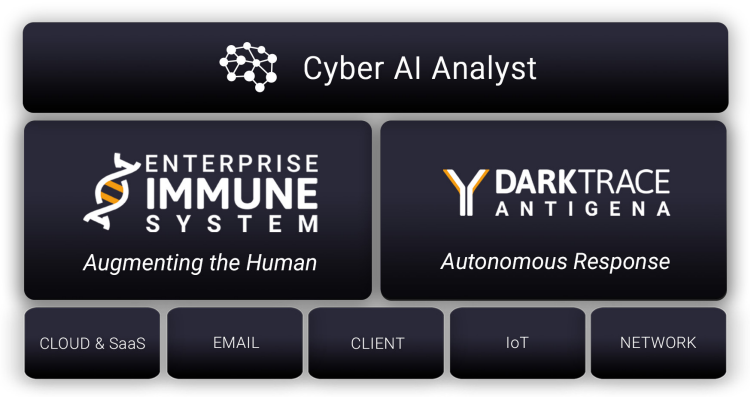
Cyber AI Analyst is a key technology grounding Darktrace’s Cyber AI Platform.
The technology can communicate valuable contextual information and response recommendations in the form of a concise, meaningful narrative that security experts can then apply their own insight to.
These “Incident Reports” are easily actioned by technical staff and executives alike and can be translated into any language at the click of a button. The reports take an average of three minutes to read, allowing even a non-technical responder to review and remediate sophisticated attacks in minutes.
While Incident Reports are always created for the most critical threats at any one time, investigations can be applied on-demand to any event of interest.
Cyber AI Analyst technology can also be integrated with tools across your security stack, allowing investigations to be triggered based on data from third-party sources like CrowdStrike or Carbon Black. The rich context and insights of Incident Reports can additionally be exported to SIEM, SOAR, or ticketing systems to enhance your existing workflows.
Mimicking a cyber security analyst’s intuition with AI
Every time any model is breached in Darktrace, it triggers the AI Analyst to launch an investigation. The AI forms hypotheses, starts asking the relevant questions and then begins to gather data – at machine speed – in order to find answers. These answers will prompt new hypotheses, and the process continues until a conclusion is formed.
Cyber AI Analyst begins its analysis as soon as the Enterprise Immune System detects a Model Breach or pattern of anomalous activity, which serves as the ‘lead’ of the investigation.
Just like a human analyst, Cyber AI Analyst starts with this lead and then asks questions to generate a plausible hypothesis about the nature of the potential threat and the potential underlying cause.
It then pivots across the enterprise to query data that may confirm, deny, or refine its hypothesis. This process is repeated continuously until Cyber AI Analyst settles on a high-level description of the nature and root cause of the wider security incident.
Cyber AI Analyst’s supervised machine learning does not use historical attack data, but rather learns on a dataset of human analyst behavior that has been accumulating over the past four years. The AI monitors Darktrace’s own experts’ behavior as they investigate threats from across our customer base, mining every action for implicit knowledge on how analysts triage threatening and suspicious activity.
Crucially, Cyber AI Analyst is able to adapt to new and unique situations on the fly, automating thoughtful examinations rather than pre-defined playbooks or encoded human knowledge.
Incident Reports can be downloaded in PDF format to be shared with relevant shareholders, enabling easy reporting for compliance or management requirements.
Generally, an Incident Report includes:
- A high-level narrative summary of the incident
- A detailed timeline pulling together all events related to the incident
- A list of related breaches and devices
- Attack phases involved in the incident (e.g. initial infection, established foothold, privilege escalation)
- Details around connections, endpoints, files, beaconing activity, and other relevant data
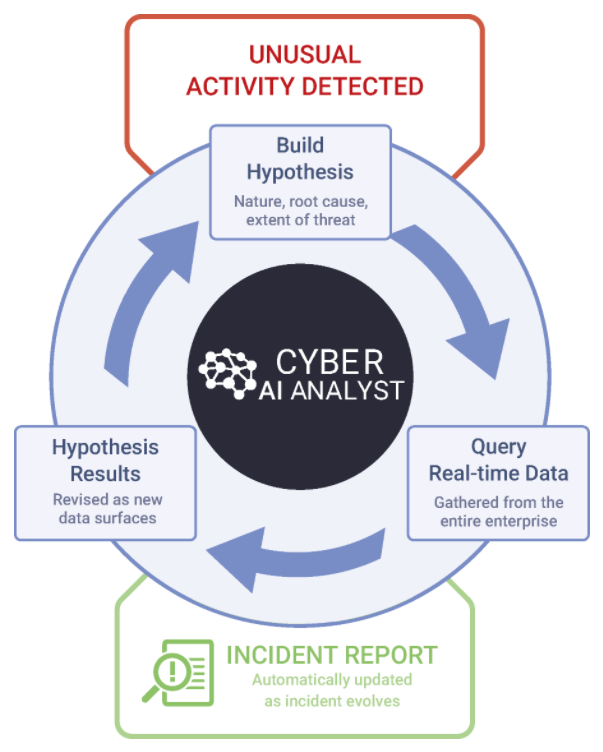
Cyber AI Analyst continuously builds and tests hypotheses, reasoning to conclusions at machine speed and scale.
Features
Investigates every threat
Trained on the behaviors of hundreds of expert cyber analysts, Cyber AI Analyst represents an industry first, conducting autonomous investigations on the full range of threats.
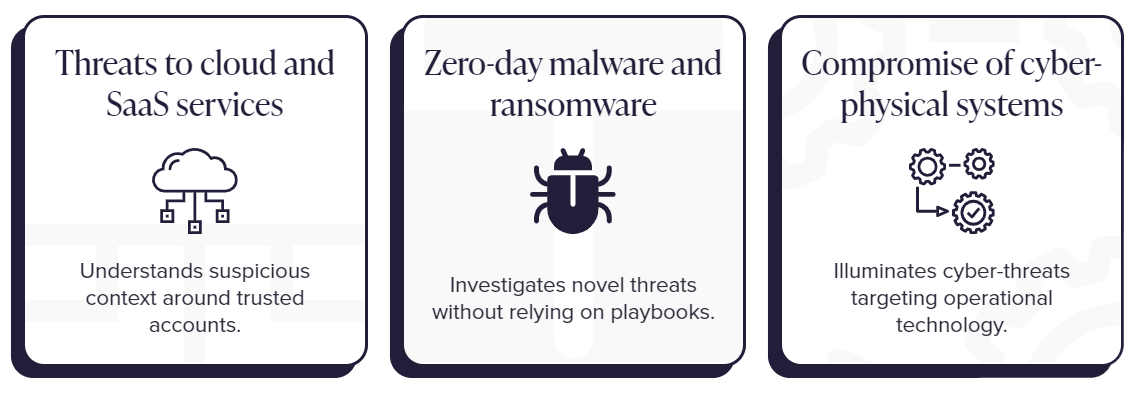
Trusted by thousands of companies
Cyber AI Analyst harnesses advanced mathematics and proprietary AI to augment thousands of security teams around the world.
The technology automatically stitches together disparate security events into a single security incident, and communicates its findings in the form of a concise, digestible narrative.
Augmenting the team
Human security analysts investigate threats by following leads, forming hypotheses, reaching conclusions, and sharing their findings. These steps take time and expertise that security teams often cannot afford. Cyber AI Analyst generates thousands of queries and follows hundreds of parallel threads simultaneously, rapidly investigating the full scope of emerging incidents.
Harnessing human flexibility
Cyber AI Analyst not only automates analyst workflows at speed and scale, but also preserves the inherent flexibility of human expertise. By adapting on the fly, the system can quickly interpret and report on security incidents characterized by innovative attack techniques that would be impossible to capture with static playbooks.
Mimicking a cyber security analyst’s intuition with AI
Every time any model is breached in Darktrace, it triggers the AI Analyst to launch an investigation. The AI forms hypotheses, starts asking the relevant questions and then begins to gather data – at machine speed – in order to find answers. These answers will prompt new hypotheses, and the process continues until a conclusion is formed.
Cyber AI Analyst begins its analysis as soon as the Enterprise Immune System detects a Model Breach or pattern of anomalous activity, which serves as the ‘lead’ of the investigation.
Just like a human analyst, Cyber AI Analyst starts with this lead and then asks questions to generate a plausible hypothesis about the nature of the potential threat and the potential underlying cause.
It then pivots across the enterprise to query data that may confirm, deny, or refine its hypothesis. This process is repeated continuously until Cyber AI Analyst settles on a high-level description of the nature and root cause of the wider security incident.
Cyber AI Analyst’s supervised machine learning does not use historical attack data, but rather learns on a dataset of human analyst behavior that has been accumulating over the past four years. The AI monitors Darktrace’s own experts’ behavior as they investigate threats from across our customer base, mining every action for implicit knowledge on how analysts triage threatening and suspicious activity.
Crucially, Cyber AI Analyst is able to adapt to new and unique situations on the fly, automating thoughtful examinations rather than pre-defined playbooks or encoded human knowledge.
Incident Reports can be downloaded in PDF format to be shared with relevant shareholders, enabling easy reporting for compliance or management requirements.
Generally, an Incident Report includes:
- A high-level narrative summary of the incident
- A detailed timeline pulling together all events related to the incident
- A list of related breaches and devices
- Attack phases involved in the incident (e.g. initial infection, established foothold, privilege escalation)
- Details around connections, endpoints, files, beaconing activity, and other relevant data

Cyber AI Analyst continuously builds and tests hypotheses, reasoning to conclusions at machine speed and scale.
Investigation
Applying Human Expertise at Machine-Speed and at Scale
Cyber AI Analyst does not try to fit events into any predefined pattern, nor does it simply look at how previous, similar event types have been categorized and responded to. Instead, it analyzes threats based on every connected detail, and considers how humans have responded in similar contexts.
The technology can replicate the decision-making of thousands of world-class analysts with the machine power of Cyber AI, meaning it can look at incredible amounts of data and correlate patterns across all parts of the digital environment.
In understanding the context as a human expert would, Cyber AI Analyst understands just how serious a threat may be and connect the dots between the related security events that make up a single threat incident.
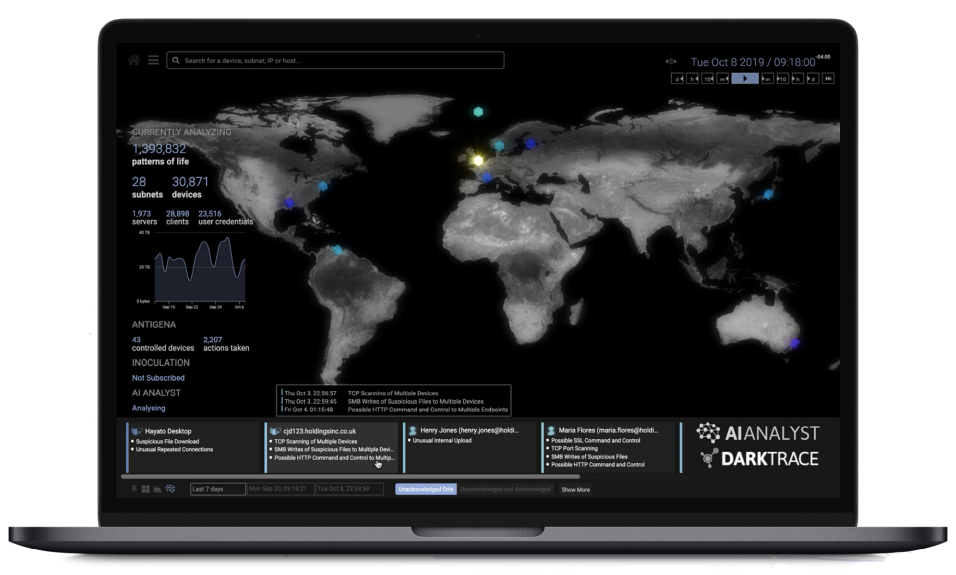
Cyber AI Analyst highlights the most significant incidents at any time, offering a cohesive narrative for each one.
Tracing Chinese Nation-State Actor APT41
When the Enterprise Immune System detected highly targeted attacks on customers in Europe and the US, Cyber AI Analyst was able to piece together the narrative and understand the severity of the threat.
Two weeks later, the attacks were attributed to a Chinese state-sponsored threat actor APT41. Yet before attribution and any threat intelligence was available, Cyber AI Analyst tied together the APT41 behavior as it emerged and highlighted the extent of the attack with striking accuracy and granularity.
The attacks targeted public-facing servers and exploited recent high-impact vulnerabilities. In one representative customer environment, Cyber AI Analyst first detected the initial intrusion, in which the APT41 actor exploited the Zoho ManageEngine zero-day vulnerability CVE-2020-10189. Then, the technology saw the Microsoft BITSAdmin command line tool used to fetch and install a malicious Batch file.
Teamviewer activity and the download of Notepad++ was also observed at the same time as command and control traffic was starting, indicating that APT41 may have been trying to use familiar tools instead of completely living-off-the-land. Cyber AI Analyst’s Incident Reports, grounded as they are in self-learning detection and expert analyst intuition, highlighted and delineated every aspect of this incident in the form of a meaningful security narrative. Even a non-technical responder could have reviewed the Incident Report and remediated this zero-day APT41 attack in minutes.
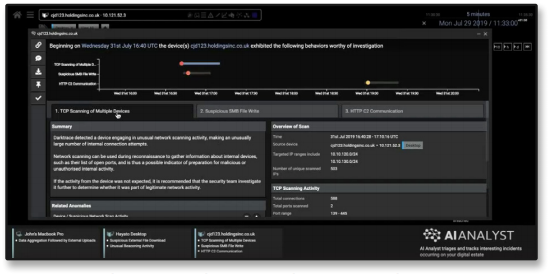
Cyber AI Analyst provides an attack summary in this sample UI image.
Sensitive Sharepoint Files Accessed Via M365
When a threat actor infiltrated an employee’s Microsoft 365 account to access sensitive financial documents hosted in SharePoint, Cyber AI Analyst immediately connected the dots between anomalous activities to paint a comprehensive narrative of the attack.
After comprising the employee’s business email, the attacker sought out important materials in the user’s SharePoint account, including pay slip and banking details. They then made configuration changes to the hacked inbox, deleting items and making updates that may have allowed them to cover their tracks.
Darktrace’s Cyber AI initially observed the actor logging in from a range of unusual IP addresses that this user had never logged in from before, nor had anyone in his peer group at the organization. This in itself was not necessarily indicative of malicious activity – after all, employees often change locations.
However, the unusual login location was accompanied by an unusual login time and a new User-Agent. As it intelligently connected all of these anomalies, Cyber AI Analyst decided to trigger a deeper investigation.
The technology used its ability to build meaningful and concise attack narratives to illuminate the likely account compromise as a high-priority incident, and compile relevant data into a human-readable report.
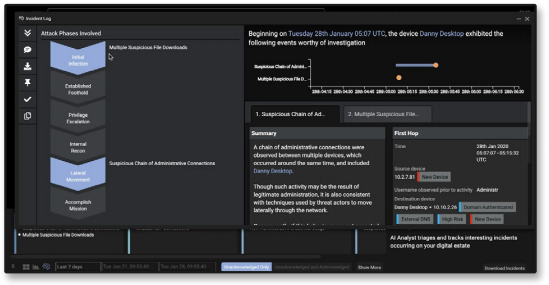
Sample UI image of Cyber AI Analyst highlighting attack phases, a timeline of events, and the incident’s source.
Boosting Productivity and Saving Critical Time
Instead of wasting valuable security staff time on manually sifting through immense amounts of data and alerts, Cyber AI Analyst lets you automate the initial investigation, applying the insight of Darktrace’s expert human analysts to allow your team to focus on strategic decision-making.
Cyber AI Analyst ensures that the most significant threats are always brought to attention first, helping prioritize limited security resources and mitigating business impact.
In a recent report with Forrester, Darktrace found that 83% of cyber security decision-makers believe that organizations require AI augmentation that can adapt to shifting threat vectors, as well as reduce time-to-detection and time-to-meaning in understanding the full scope of an incident.
Cyber AI Analyst responds to this need perfectly, slashing the time-to-response and time-to-meaning when a threat is detected, and reducing triage time by up to 92%.
The technology also helps reduce the rate of false positives, mitigating alert fatigue for already over-worked teams and making their jobs more fulfilling.
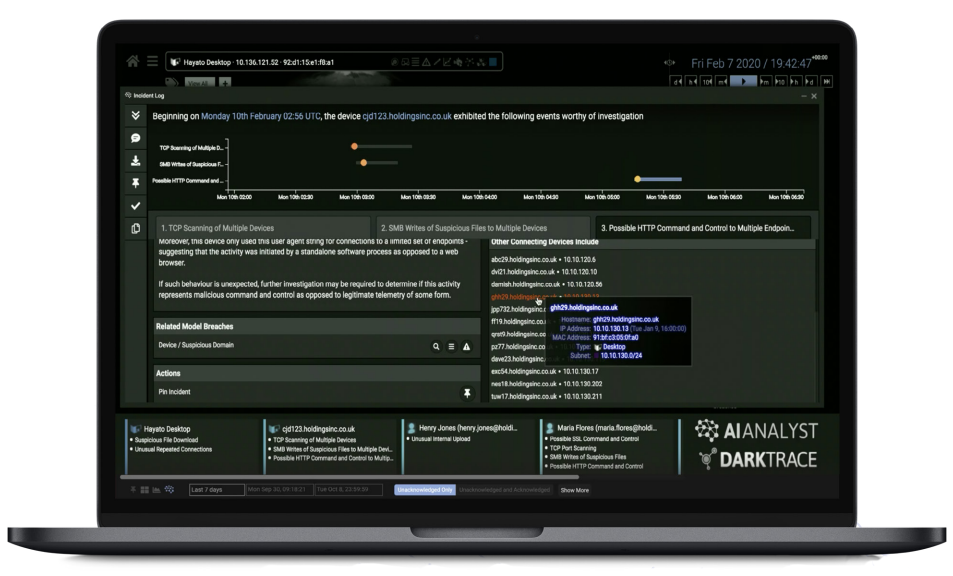
Cyber AI Analyst offers a high-level incident timeline and summary, as well as granular details.
Multi-Stage Network Vulnerability Attack
When a threat-actor took advantage of vulnerabilities on multiple devices at a US pharmaceuticals company, Cyber AI Analyst proved crucial in illuminating every step the attacker took and responding to the threat.
Darktrace’s Cyber AI first saw a company desktop making a new connection to a second internal device using the Remote Desktop communication protocol and administrative credentials. While this connection was ongoing, the second device made a connection to an internal server using the SMB file sharing protocol. With this connection, the second device wrote to a hidden file share on the internal server, an activity that had never been seen before in this context.
While the initial new connection was not necessarily suspicious, Cyber AI Analyst was able to correlate all of this activity to understand how each subtle anomaly was part of the wider threat narrative.
In understanding that the activity may have indicated an attacker working their way through vulnerable network devices to gain access to critical infrastructure and resources, the technology was able to alert the security team to the emerging threat immediately and provide crucial contextual information, along with response recommendations.
With Cyber AI Analyst augmenting the initial investigation steps, the security team was easily able to ensure that a serious, multi-stage incident was neutralized as soon as possible.
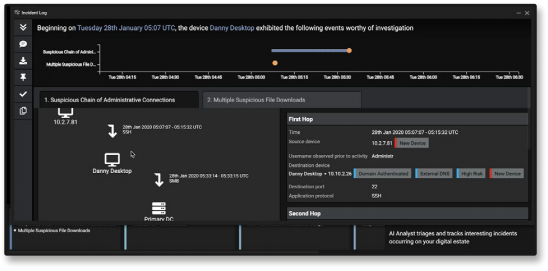
Cyber AI Analyst visually represents a multi-stage attack moving through devices in this sample UI image.
SaaS Account and Documents Compromised
At a global produce supplier, several suspicious requests within the company’s Box platform suggested that an account had been compromised. A user logged in to the Box account from a country that the organization typically operates in, but from an unusual IP space and ASN. With this suspicious and unusual detail, Cyber AI Analyst automatically actioned further investigation into the user’s activity.
The actor behind the account proceeded to download expense reports, invoices, and other financial documents. It soon became evident that the user was reading files that were highly unusual for the account to access. Darktrace Cyber AI recognized that neither the account itself, nor its peer group, usually accessed the file called ‘PASSWORD SHEET.xlsx’.
Cyber AI Analyst’s automated investigation was able to shine a light on the greater narrative, understanding that each unauthorized file exposure was part of a connected incident. The technology highlighted the breach as a key concern for the security team, and summarized all related behavior in an actionable Incident Report.
With Cyber AI Analyst illuminating the initial, unusual behavior as part of a more significant threat and making the relevant contextual data easily accessible, the security team had the power to respond more quickly and efficiently to an attack that might have otherwise gone unnoticed.
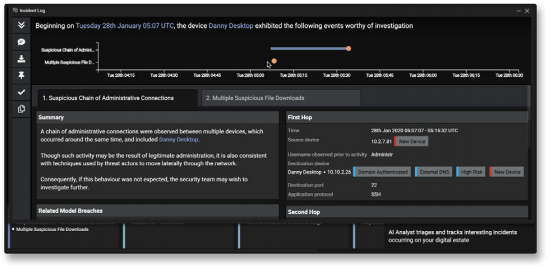
Sample UI image shows Cyber AI Analyst identifying unusual administrative activity and file downloads.
Jumpstarting Remediation with AI-Driven Insights
Cyber AI Analyst was designed to help teams jumpstart remediation with its concise Incident Reports. These reports bring the deep visibility and comprehensive situational awareness of Cyber AI into a cohesive narrative, which is continuously revised as incidents evolve.
New activity and data prompt Cyber AI Analyst to automate further investigations and test new hypotheses, so that your team always has the most up-to-date insights grounding their response decisions. The reports can be used to understand the root cause of an incident, the extent of an attack, and may even reveal unexpected infrastructural vulnerabilities. In this way, the technology can be leveraged to evolve your security posture.
Cyber AI Analyst technology also makes reporting a simple, low-friction process – even when it’s a complex incident that needs to be shared with executives, board members, or even legal authorities.
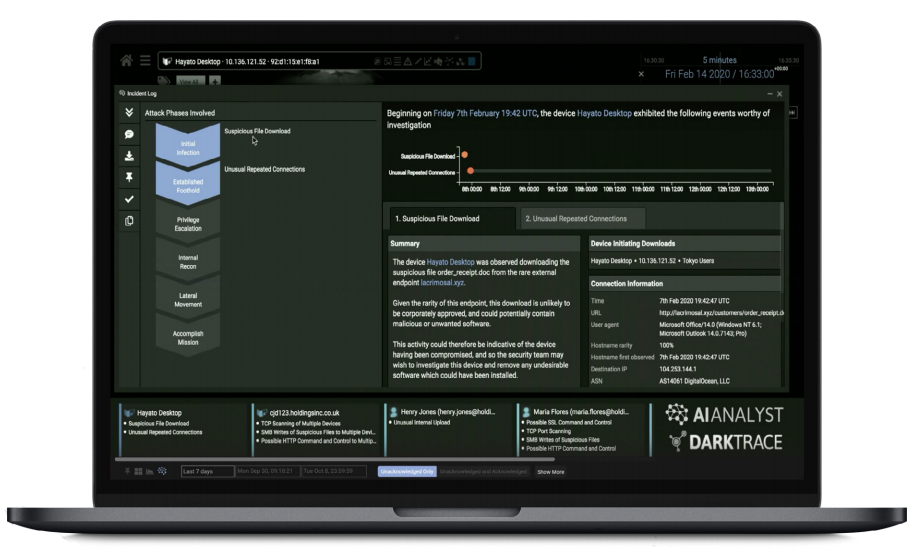
Cyber AI Analyst clearly presents the attack status and recommendations for next steps.
Conficker Virus Evades Legacy Tools
When Darktrace’s Cyber AI saw a device making large volumes of DNS requests for domains that appeared to be algorithmically generated, Cyber AI Analyst immediately understood the gravity of the situation and presented an Incident Report to the security team.
Based on Cyber AI Analyst’s clear narrative of the event, the human analysts were able to see that the device was likely infected with the Conficker worming virus. Subsequent investigation revealed that this was likely to be a highly targeted attack, as the company’s antivirus provider had rules configured to detect Conficker – yet this device appeared to have been configured incorrectly and was therefore able to be penetrated.
Without Cyber AI Analyst highlighting the root cause of this incident, the security team likely would not have known that the device was lacking adequate security configuration, and the device in question certainly could have been seriously compromised and damaged. However, with Cyber AI Analyst’s ability to illuminate the context and extent of the incident, the security team was instead able to contain the device and mitigate further business impacts.
Cyber AI Analyst’s investigation and report empowered the security team to quickly engage in comprehensive remediation efforts, with a new understanding of their existing security coverage and potential vulnerabilities.

In this sample image, Cyber AI Analyst offers details on a breached device and lists similar devices – giving security teams critical context for remediation.

